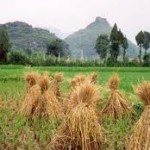The increased cost of energy dependent fertilizer and the need to conserve plant nutrients by recycling them have focused attention to organic material sources of fertilizers. One of the cheapest and most available organic substances is rice straw.
In the tropics, the straw mass corresponding to 1 ton of sun dried paddy rice is 1.5 tons which contains about 9 kilos of nitrogen, 2 kilos each of phosphorus and sulfur, 25 kilos of potassium, 70 kilos of silicon, 6 kilos of calcium and 2 kilos of magnesium based on a study by the International Rice Research Institute (IRRI) of 1984.
Rice straw is thus a good source of macro-nutrients. Burning rice straw, a usual practice in most farms in the Philippines, destroys most of the nitrogen, sulfur, some of the potassium and makes silicon less available.
Herewith, are ways of how to get the benefits and the most of the rice straw.
*** To return the nutrients of rice straw to the soil, cut rice stalks higher during harvest time. More stubble are then incorporated into the soil during land preparation.
*** Threshed straw can be fed to animals or can be used for feeding livestock during fodder shortage. Some of the rice straw nutrients are subsequently returned to the soil as animal excreta.
*** Pile rice straw in mounds in successive quadrants in the field each cropping season to even out nutrient distribution. The rice straw will decompose slowly when incorporated into the soil during land preparation. The practice of piling and spreading the straw saves labor but reduces the area planted to rice.Incorporating the straw in place achieves fertilizer savings and aids nutrients recycling.
*** The effect of time in straw incorporation on grain yields depend on the temperature, cultivar and the amount of straw. In warm regions, 1 month after straw incorporation, all the rice straw produced in a field could be plowed immediately before transplanting without adverse effects. The application of nitrogen and phosphorus enhances the benefit of straw incorporation.
*** The initial yellowing of leaves of the rice seedlings caused by decomposition of straw can be checked by the addition of nitrogen and phosphorus. Nitrogen is used by the rice at the early stage of growth. The peak of nitrogen absorption from straw comes in the middle growth stage, coinciding with peak crop demands.
*** The incorporation of straw reduces the incidence of tungro, rice blast and blight.
*** The benefit of straw incorporation or rice yield appears during the rainy season of application and increases with subsequent incorporation of straw.
